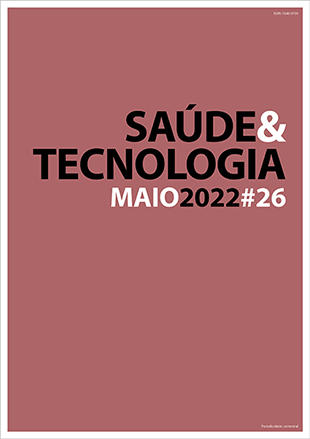Effect of caffeine and cognitive tests on cerebral hemodynamic in young students from the Dr. Lopes Dias Superior Health School
DOI:
https://doi.org/10.25758/set.489Keywords:
Caffeine, Transcranial color-coded duplex sonography, Cerebral arteries, Cognitive testsAbstract
Introduction – Caffeine induces physiological changes, such as increased blood pressure, which is reflected in cerebral hemodynamics. Objectives – Evaluate the effect of caffeine on changes in the flow of the cerebral arteries studied, as well as relate their effect with cognitive tests. Methods – Observational, prospective study in 35 students, aged between 18 and 25, at Escola Superior de Saude Dr. Lopes Dias. The volunteers were divided into two groups, with group 1 having a normal coffee and group 2 being a white brand decaffeinated, without added sugar. The procedure was divided into two phases, pre- and post-stimulant. Data were collected through the transcranial color-coded duplex sonography and the MoCa cognitive test, after free and informed consent. On the course of study was assured the principles of the Declaration of Helsinki. The following non-parametric tests were used to correlate the variables: Wilcoxon, Spearman, and Mann-Whitney. Results – Compared to baseline, in the caffeine condition there was an increase in flow variations in the middle cerebral arteries (p=0.0001), the same happened with the MoCa Test score (p=0.0001). Discussion – In the analysis of the flow of the main cerebral arteries and when performing cognitive tests, there is a significant increase in the flow under the effect of the caffeine, although this is more noticeable in the middle cerebral artery. Conclusion – The middle cerebral artery is the artery most susceptible to modifications, however, these are independent of the beverage with caffeine used, the same happens when performing the MoCa Test.
Downloads
References
VanPutte C, Russo A, Regan J. Anatomia e fisiologia de Seeley. 10ª ed. McGraw-Hill Brasil; 2016. ISBN 9788580555882
Marieb EN, Hoehn K. Anatomia e fisiologia. 3ª ed. ArtMed; 2009. ISBN 9788536315508
Zétola VF, Lange MC, Muzzio JA, Marchioro I, Nóvak EM, Werneck LC. Doppler transcraniano na prática neurológica [Transcranial Doppler in the neurological practice]. Arq Neuropsiquiatr. 2006;64(1):100-3. Portuguese
Bleton H, Perera S, Sejdić E. Cognitive tasks and cerebral blood flow through anterior cerebral arteries: a study via functional transcranial Doppler ultrasound recordings. BMC Med Imaging. 2016;16:22.
Montoro CI, Duschek S, De Guevara CM, Fernández-Serrano MJ, Reyes del Paso GA. Aberrant cerebral blood flow responses during cognition: implications for the understanding of cognitive deficits in fibromyalgia. Neuropsychology. 2015;29(2):173-82.
Aguiar RA, Turnes T, Cardoso TE, Vasconcellos DI, Caputo F. Efeito da ingestão de cafeína em diferentes tarefas de tempo de reação [Effect of caffeine ingestion on different reaction time tasks]. Rev Bras Ciênc Esporte. 2012;34(2):465-76. Portuguese
Perod AL, Roberts AE, McKinney WM. Caffeine can affect velocity in the middle cerebral artery during hyperventilation, hypoventilation, and thinking: a transcranial Doppler study. J Neuroimaging. 2000;10(1):33-8.
European Coffee Federation. European coffee report 2018/2019 [Internet]. Brussels: ECF; 2019. Available from: https://www.ecf-coffee.org/wp-content/uploads/2020/09/European-Coffee-Report-2018-2019.pdf
Roehrs T, Roth T. Caffeine: sleep and daytime sleepiness. Sleep Med Rev. 2008;12(2):153-62.
Shah S, Kumar A. Coffee: constituents and health benefits. Biotechnol J Int. 2020;24(5):22-38.
Hoffman R. Screening, cognitive. Encyclopedia of behavioral medicine. Springer; 2020. p. 1961-4. ISBN 9783030399030
Castro SL, Cunha LS, Martins L. Teste Stroop Neuropsicológico em Português [Internet]. Porto: Faculdade de Psicologia e Ciências da Educação; 2000 [updated 2009 Mar]. Available from: https://repositorio-aberto.up.pt/bitstream/10216/9191/2/44478.pdf
Betz ME, Fisher J. The Trail-making Test B and driver screening in the emergency department. Traffic Inj Prev. 2009;10(5):415-20.
Moura O, Simões MR, Pereira M. Fluência verbal semântica e fonêmica em crianças: funções cognitivas e análise temporal [Semantic and phonemic verbal fl uency in children: cognitive functions and temporal analysis]. Aval Psicol. 2013;12(2):167-77. Portuguese
Simões MR, Freitas S, Santana I, Firmino H, Martins C, Nasreddine Z, et al. Montreal Cognitive Assessment (MoCA): manual de administração e cotação. Coimbra: Faculdade de Psicologia e Ciências da Educação e Hospitais da Universidade de Coimbra; 2008.
Janota I. Clinical neuro anatomy. J Neurol Neurosurg Psychiatry. 1980;43(11):1050.
Boban M, Črnac P, Junaković A, Malojčić B. Hemodynamic monitoring of middle cerebral arteries during cognitive tasks performance. Psychiatry Clin Neurosci. 2014;68(11):795-803.
O’Dell DM, Roberts AE, McKinney WM. Transcranial Doppler monitoring of middle cerebral artery blood flow velocities during three memory tasks. J Neuroimaging. 1992;2(4):186-9.
Boban M, Cmac P, Junaković A, Garami Z, Malojčić B. Blood flow velocity changes in anterior cerebral arteries during cognitive tasks performance. Brain Cogn. 2014;84(1):26-33.
Roberts AE, McKinney WM. Blood flow velocities in three cerebral arteries in the same subjects modulate during thinking. J Neuroimaging. 1998;8(4):191-6.
Downloads
Published
Issue
Section
License

This work is licensed under a Creative Commons Attribution-NonCommercial-NoDerivatives 4.0 International License.
The journal Saúde & Tecnologia offers immediate free access to its content, following the principle that making scientific knowledge available to the public free of charge provides greater worldwide democratization of knowledge.
The journal Saúde & Tecnologia does not charge authors any submission or article processing charges (APC).
All content is licensed under a Creative Commons CC-BY-NC-ND license. Authors have the right to: reproduce their work in physical or digital form for personal, professional, or teaching use, but not for commercial use (including the sale of the right to access the article); deposit on their website, that of their institution or in a repository an exact copy in electronic format of the article published by Saúde & Tecnologia, provided that reference is made to its publication in Saúde & Tecnologia and its content (including symbols identifying the journal) is not altered; publish in a book of which they are authors or editors the total or partial content of the manuscript, provided that reference is made to its publication in Saúde & Tecnologia.







